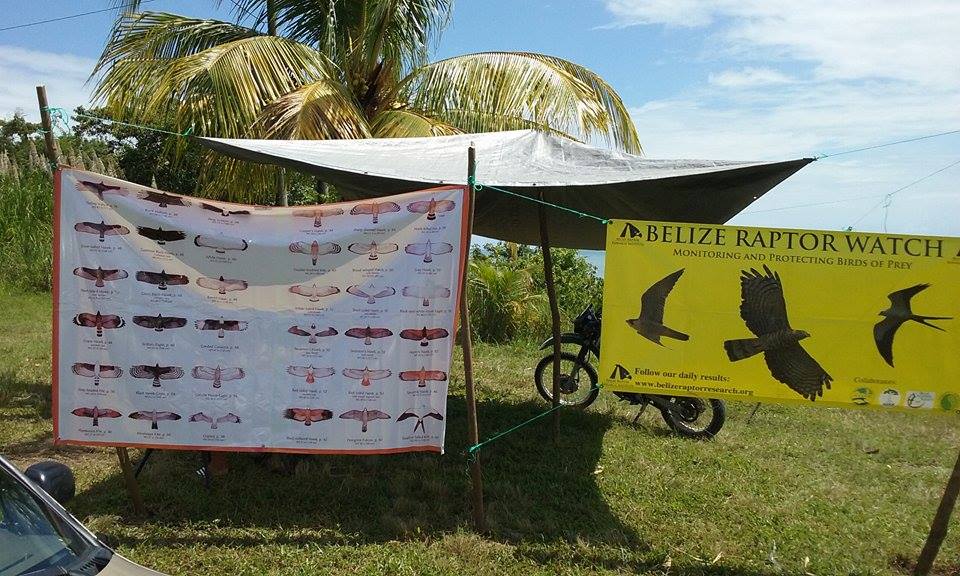hawk watch project
Healthy tropical raptor populations are essential for maintaining the function of complex and dynamic tropical ecosystems, but tropical raptor populations are declining precipitously due to anthropogenic factors such as persecution and habitat loss. Raptor migration monitoring stations (hawk watches) provide a relatively simple way to monitor raptor populations and conduct research on the movement ecology of tropical raptors that are otherwise challenging to study due to their secretive nature, low abundance and density, and sometimes complex long-distance movements. Hawk watch programs can assist with providing information on populations that can guide conservation and create educational, economic, and conservation opportunities for local communities.
Raptor migration monitoring through hawk watch counts started in the early 1930’s in the United States, which first was inspired for the purpose of documenting the magnitude of raptor migration and gaining conservation support to reverse the trend of raptor population declines. Hawk watching pioneers understood the impact of bringing people to hawk watch sites to have them observe migrating raptors to build support for raptor conservation. Since then, many observation sites have been initiated across the globe though many have had trouble continuing operation due to funding constraints, and lack of local capacity and support. However, that is quickly changing. The longest operating raptor migration monitoring site in the Neotropics is in Veracruz, Mexico, a site co-founded by Ernesto Ruelas Inzunza, Laurie Goodrich, and Stephen Hoffman in 1991. This pioneering site, the first established in the Neotropical region, has documented the greatest magnitude of migrating raptors on earth, and has inspired our work in Belize and others around the globe.
In 2013, the Belize Raptor Research Institute (now called the Belize Bird Conservancy) initiated Belize Hawk Watch in southern Belize. This was the first, and currently the only, raptor migration monitoring program in Belize. The Belize raptor migration corridor is key for both Nearctic-Neotropical migrants, intra-tropical migrants, and “island-hopping” species that migrate south through Florida before following the islands in the Caribbean Sea, such as Cuba, before making landfall in the Yucatán Peninsula, Mexico and continuing south through Belize. Many new and important discoveries of raptor populations and movements in this region have been obtained through the program.
Prior to this program, Nearctic-Neotropical migratory raptors breeding in the temperate region were considered rare and not thought to pass through Belize on their southbound migration, instead taking a more westerly route through Guatemala (Weyer 1984, Miller and Miller 1998, Bildstein 2004). H. Lee Jones (2004) made many of the first documented observations of migrating raptors in Belize and changed the way we thought about migratory raptors in the region, which was part of the inspiration for establishing our program. Between 2013-2023, Nearctic-Neotropical migratory raptors accounted for 37% of the migratory raptors counted at the Belize Hawk Watch (Table 1), suggesting that the temperate region-breeding raptors that migrate into the Neotropics for the non-breeding months do in fact move through Belize, and, despite the low abundance compared to Guatemala, Belize is also an important movement corridor.
Since the launch of the program in 2013, we have recorded more than 180,000 raptors (average=16,381 per year) of 38 species, 52% of which were migratory and 48% of which were non-migratory. The four most abundant migratory species were Hook-billed Kite (Chondrohierax uncinatus; average 5,282 per year), Mississippi Kite (Ictinia mississippiensis; 1,224 per year), Broad-winged Hawk (Buteo platypterus; 1,126 per year), and Peregrine Falcon (Falco peregrinus, 376 per year).
For Hook-billed Kite, a species that is often described as non-migratory (Greeney and Boesman 2022), we documented the first comprehensive country data on its migratory movements, and the greatest number of migrating individuals anywhere through their range (Phillips 2021, Phillips et al. 2015, Phillips et al. 2023). Other findings include the first documented migration of Double-toothed Kite (Harpagus bidentatus), and the documentation of a significant migration of juvenile Mississippi Kites (Ictinia mississippiensis). Belize has by far the largest migration of Hook-billed Kites observed in the world. Between 2013-23, while monitoring post-breeding (southbound) Nearctic-Neotropical raptor movements, this species made up 62% of all migrants counted, with more than 58,000 tallied during all seasons. On a single day (10 November 2022), we counted a record 2,068 migrating Hook-killed Kites, with one flock totaling 288 individuals. By comparison, the well-known raptor migration site at Veracruz, Mexico tallies an average of approximately 155 Hook-billed Kites annually (Phillips et al. 2023).
The Belize Hawk Watch has proven to be a model for Central America and the Neotropics. Part of the success of this program has been securing stable financial and community support plus having a group of Belizean hawk watchers that are dedicated to the success and sustainability of the Belize Hawk Watch. This program has reached thousands of Belizeans of all ages through outreach events and welcoming visitors to the hawk watch count site.
The notable discoveries and other findings of the Belize Hawk Watch exemplify how relatively little is known about Neotropical raptor migration and movement ecology, and the large information gaps remaining. The Belize Hawk Watch and the Raptor Certification Program highlight the importance of building local capacity and garnering community participation for data collection to enhance raptor conservation efforts.
Publications























